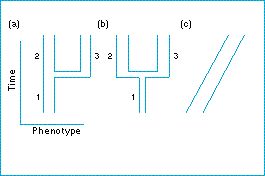Cladistic species concept

In the cladistic species concept, a species is a lineage of populations between two phylogenetic branch points (or speciation events).
The cladistic concept recognizes species by branch points, independently of how much change occurs between them.
Because of this, the two patterns in the figure are cladistically identical: in both there are three species and species 1 gives birth to two new species at the branch point. On the non temporal species concepts, such as the biological, recognition and ecological species concepts, there are two species in Figure (a) and three in (b).
Figure: two types of speciation. (a) The ancestral species does not change phenetically (or reproductively or ecologically) after a daughter species evolves. Species 1 and 2 are phenetically identical but cladistically different. (b) The ancestral species changes after the evolution of the new species; species 1 and 2 are both phenetically and cladistically different. (c) Phenetic change in one lineage with no speciation.
| Next |



